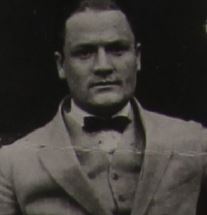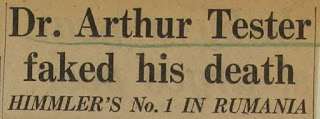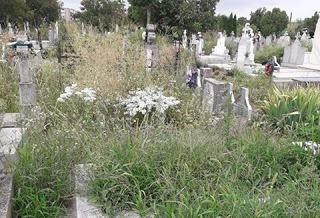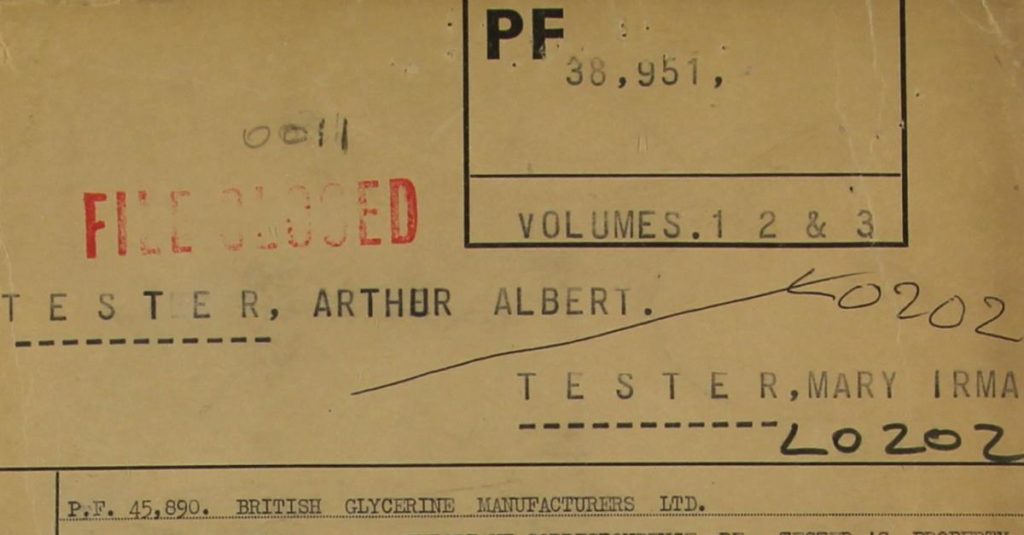N.B. This is Part 3 in a four part series on Dr. Arthur Albert Tester:
Part 1 can be found here
Part 2 can be found here
Part 4 can be found here
There have been a lot of rumours and theories about how and when Arthur Albert Tester left England. One particularly glamorous story relates how Tester left the shores of Britain in August 1939, shortly before the declaration of war. According to the story… Tester trotted down the 39 Steps opposite his Broadstairs mansion and then scurried across the beach to be spirited away by a German submarine. The truth is not quite so James Bond-ish…
Departing Britain

Sometime before December 1938, Tester bought the SY Lucinda, a steam yacht (588 tons gross) for £7500 from B.L. Koppenhagen, Alton House, Bessborough, Roehampton. Some authors say that Tester used to entertain lavishly on his yacht and even hosted foreigners. This might refer to the SY Lucinda, but it could also be a reference to the Blue Bird yacht which Tester rented in September 1938. Tester sailed the Blue Bird from Southampton down to France, picked up a load of foreigners and headed for Dublin where the group held business meetings onboard. Tester was also a member of the Royal Motor Yacht Club having been nominated by Admiral White who, coincidentally, sat on the Board of Directors of Thor Engineering, one of the companies with which Tester was associated.
While we don’t know exactly when Tester purchased the SY Lucinda, we do know that on 17 December 1938, the yacht left Messrs. Camper & Nicolson’s Yard and tied up to a buoy in Southampton Water. The yacht had a crew of 24 and apparently cost about £300/week to run. On 24 December, a number of passengers boarded the yacht from a launch in Southampton and the yacht set sail for the Mediterranean. The passengers included Arthur Albert Tester, Charlotte Tester (wife), Margit Tester (daughter), Mary Tester (daughter), Lilian Tester (daughter) and Arthur Uckert (illegitimate son of Arthur and Charlotte). There were also a number of household staff including a governess and Tester’s personal valet.
A follow-up report on the SY Lucinda came from Gibraltar on 30 December, 1938, and noted that there were 28 British crew on board and 11 passengers: Tester and his five family members plus five guests. Household staff may have been counted as “crew”. The Gibraltar report noted “nothing of any interest regarding the passengers was reported”. There were, however, some interesting passengers who had boarded in Lisbon including Richard Wilhelm Behn (Tester’s Hamburg lawyer), Reinemer, Frisch (both Tester’s business partners) and an unnamed German government official. Charles Paquet, another one of Tester’s business partners boarded the yacht in Gibraltar.
Cruising the Med
Tester’s merry band then set sail for Egypt and arrived in Port Said in January 1939. The yacht sailed halfway down the Suez Canal and stayed in Lake Timsah by Ismalia for four days. The British security officers in Egypt noted no suspicious activity associated with Tester or his crew.
On 15 February, the yacht set sail from Port Said bound for Cyprus, Istanbul, Athens, Malta and Gibraltar. There are a few snippets in newspapers of the time which indicate that the Lucinda went aground on sandy bottom near Yenikoy in the Black Sea, just northwest of the Bosporus and that the Captain requested assistance. The grounding must have created a bit of excitement for crew and guests. Tester likely too advantage of the delay to renew some business connections in Turkey; he had been a close personal friend of the Atatürk (who had passed away in November 1938).
Back in England, MI5 was gathering evidence against the shady financier. Several documents note that MI5 expected Tester to return to England by April 1939, and they wanted to be prepared for his arrival. MI5 requested that British officials in the Mediterranean keep an eye on Tester whenever and wherever he might appear. They also noted that the Dutch insurance investigation (N.V. Patria) was still not complete in March 1939. That same month, MI5 wrote to Special Branch to let them know that Tester’s father “was never a British Consul as alleged and there is no information to show that Tester took any degree which would entitle him to use the word ‘Doctor’.” More and more questions were piling up around Tester, and both the police and MI5 were awaiting Tester’s return with anticipation.

April came and went and yet the SY Lucinda didn’t arrive in Southampton as scheduled. MI5 made some enquiries and learned that she was in dry dock in Naples. Interviewing Tester would have to wait but, in the meantime, MI5 was able to question several members of the ship’s crew who had left the ship and returned to England. Reasons for their departure from the SY Lucinda varied: some were disgusted with Tester’s anti-British talk while others were afraid of a coming war after the Albanian crisis (Italy’s April 1939 invasion of Albania). MI5 interviewed the crew members and several thought that Tester was a spy who covered up his activities under the guise of doing business in wines and oil. Tester told many tall tales, claiming to be a personal friend of Mussolini. He even told his personal valet that he had been in the British Secret Service during the First World War and showed the scars on his legs to prove it. [Those scars were likely from Tester’s 1924 motor vehicle collision with a train in Germany]. All of the crew members agreed that Tester, his wife and his associates expressed strong anti-British sentiment.
As for Tester, he remained in Italy, entertaining guests and trying to make a number of business deals in wine and other items. Some of the guests who joined him are familiar to us from Tester’s shell companies (e.g. Captain O’Reilly – BUF member) while others are new (e.g. Josef Emil Roos – more on him in another blog post). Apparently Palvary, the inventor of the bullet-proof aeroplane fuel tank, also joined Tester in Italy and the pair tried to sell the tank to the Italians. They set up a demonstration which failed miserably and the Italians rejected the fuel tank out of hand.
WAR!
With the declaration of war in early September 1939, Tester and the SY Lucinda departed Italy and sailed from Naples to Greece where Tester’s wife and children disembarked. Tester then sailed with the ship to Port Said where it was handed over to the Royal Navy. While in Egypt, Tester managed to arouse the suspicion of the Egyptian authorities and was arrested for hanging out with drug dealers and espousing fascist ideals. An investigation cleared him of any wrongdoing, other than securing drugs (ambergis) for his own use, and the Egyptian authorities decided to deport him to England where MI5 and the police would have welcomed him with open arms and a set of handcuffs. Somehow this deportation plan got changed and Tester was only deported out of Egypt, boarding a plane for Greece on 4 October 1939. The British authorities managed to rifle through his trunk and personal possessions but found no evidence of espionage. Nevertheless, on 1 November 1939, Tester was put on Britain’s Central Security War Black List. As for his yacht, the SY Lucinda does make an appearance in a 23 February 1945 article in the Chelmsford Chronicle. Apparently a military wedding reception with 100 guests was held aboard the yacht Lucinda in Alexandria, Egypt. It is unclear how else the SY Lucinda helped the British Navy’s war effort.
Tester, like a cat, landed on his feet in Greece. In November 1939, he contacted the British consular staff in Athens and laid out a proposition that would benefit both Britain and himself. He proposed to buy up foodstuffs in Yugoslavia, Roumania, Bulgaria and Greece in order to keep them out of German hands. He would then sell the foodstuffs to the British Government for a modest profit. Despite not receiving the go-ahead from the consular staff, Tester began to buy up foodstuffs and apparently told the sellers that he was working on behalf of the British Government. The British Ministry of Food had to tell their Yugoslavian contacts that Tester was most definitely not recognized by His Majesty’s Government. On top of that, Tester bought the foodstuffs at higher than normal prices and most of the goods he purchased were subject to prohibition orders and/or were unsalable in the UK. What became of the foodstuffs is unknown. If he couldn’t sell them to the British, then to whom did he sell them?
By December 1940, Tester had moved his base of operations from Greece to Roumania and MI6 received word that Tester was doing business with the Germans. At the same time, he wasn’t above demanding assistance from the British, whose passport he still carried. He presented himself at the British Consulate in Bucharest in December 1940 requesting assistance. Two of his children were still in Greece and they needed help with their passports in order to travel to Roumania. At the time, Tester told the consular staff that he was a middle-man, buying up Jewish businesses and selling them to third parties (for a profit). Finally, in February 1941, Tester managed to get his children out of Greece and thereafter, information on him becomes quite sketchy, at least from the British perspective. After the war, the Allies got their hands on German documents and also interviewed several former Abwehr officers, all of which shed a rather illuminating light on Tester’s activities from 1940-1944.
Operative of the Abwehr
In October 1940, German troops began to enter Roumania and in November of that same year, Roumania joined the Axis forces. As a British citizen, Tester would naturally have come under suspicion by the German authorities. And, indeed, Joachim Rohleder, head of Abwehr IIIF in Berlin, believed that Tester had worked for British intelligence prior to the war and ordered that he be arrested and sent to a concentration camp. The head of Abwehr IIIF in Roumania, Kurt von Rohrscheidt, disagreed and stated that Tester was pro-German and quite prepared to work for the Abwehr without pay. Rohleder agreed to allow Rohrscheidt to use Tester as an agent of the Abwehr. According to Rohrscheidt, Tester’s first mission under Abwehr IIIF was in Sofia, Bulgaria. Tester, posing as a British (or American) officer, penetrated an underground movement of Macedonians who wanted to overthrow the government which was friendly to the Axis Powers. Tester obtained a complete list of personalities in the movement and the details of the plan for overthrowing the Bulgarian government.
That same year, Tester, through his work for a bank controlling organisation, had access to bank records in Athens, and was able to examine cheques and other documents signed by British intelligence officers. With those names, Tester was able to infiltrate the Greek resistance fighters as well as learn the names of British operatives in Roumania.
As an Abwehr operative, Tester moved around a fair bit, working in Roumania, Bulgaria and Greece on counter espionage work. One of Britain’s sources in Greece, noted that a Greek banker had told the source that he had seen Tester working in one of the Nazi offices in Athens “resplendent in Gestapo uniform”. This is the first mention of Tester being associated with the Gestapo and, to my mind, needs to be taken with a grain of salt. All of the German sources state that Tester worked for the Abwehr and that the SIPO/SD (Sicherheitspolizei and Sicherheitsdienst) were very wary of Tester. It would be hard to imagine that the Gestapo, a branch of the SD would have allowed Tester to work for them. It is possible that Tester was dressed in a German uniform, although unlikely. It is also possible that the source was simply exaggerating Tester’s involvement with the Germans in order to cause trouble for him.
Anglia, Quo Vadis?
In April 1941, Tester published a series of extracts from his book Anglia, Quo Vadis? in a Romanian newspaper. Written with a rather strong anti-Jewish and anti-British tone, the article’s byline stated that:
“Out of the whole of the General Staff of the British Fascists the only leading man who is free and who took refuge abroad is Dr. Arthur Tester who bears of the title of Personal Conduct Officer of the Party Chief. By holding such a high commission, he is one of the intimate collaborators of Sir Oswald Mosley.”
Given that Mosley, and much of the BUF leadership, were interned in Britain, Tester could pretty much claim anything that he wanted without fear of being found out. The British got wind of his Quo Vadis articles and noted that Tester spoke “disparagingly” of Britain and the British war effort. He was to be arrested if he ever set foot in any British territory again.
So much for Tester’s avowal to a British newspaper reporter in March 1938: “If a war came with Germany I should be among the first to go into the trenches.” In April 1941, Tester wrote a letter to Germany’s ambassador to Roumania, Manfred Freiherr von Killinger in which he stated, “May I once again state that I place myself completely, loyally and without reservation, at your disposal for active co-operation, and naturally neither expect financial reward nor would I accept it.”
Tester suggested a number of ways in which he could be of assistance to the Germans and the fascist cause. He suggested writing a series of articles, in line with the Anglia, Quo Vadis? series, but these would be entitled I am an Englishman. Tester convinced the Germans that he was known throughout England and that he would be accepted as an official representative of the BUF. The Nazis rather liked the sound of the articles and Tester went to Berlin in the summer of 1941 to discuss working for the Press Section of the Foreign Ministry. It would appear, from several German documents, that he was hoping to move to Berlin in September 1941. The plan was that he would not be paid for the work but that he would receive a monthly stipend from his frozen German bank accounts. Before the deal could be finalized, Tester was once again sent on a mission for the Abwehr to Athens, Belgrade and Sofia.

The salutation translates as “Your very devoted, Heil Hitler! Dr. A. Tester”
Letter written to Oberfuehrer Roedel, Deutsche Gesandtschaft.
This is likely Oberfuehrer S.A. Willy Roedel who served as Political Adviser to the German Ambassador Manfred von Killinger in Bucharest. Roedel was captured by the Russians in November 1944 and would eventually share a cell with Raoul Wallenberg. But that’s another story.
There was, however, some concern about Tester’s true loyalties. Abwehr III thoroughly approved of Tester and thought that he was unobjectionable and reliable. He had been working for them with great success and had a steady pro-German attitude. The SIPO/SD, however, had looked at his history and thought that he was politically unsound and had a number of crimes against him. They noted that he was an international swindler and a profiteer in arms and explosives. In the end, the Foreign Ministry sided with the SIPO/SD and decided not to employ Tester.
The following year, Tester was once again in Berlin to discuss performing propaganda work for Germany. He had told the German authorities that Italy was interested in his book. The Foreign Ministry once again expressed some interest in him writing a series of articles in line with Anglia, Quo Vadis?. Unfortunately, when Tester went to Berlin to discuss his work, he seemed more interested in setting up a satellite BUF group in Roumania and sending out press broadcasts to England. Interradio in Berlin wanted to use him for their English section but they were informed, in no uncertain terms, that Tester was not suitable for active employment with them.
The SIPO/SD were very wary of Tester and ordered that his plans to offer himself to Italy or Roumania be hindered. At the same time, there were rumours that Tester was embezzling funds in Roumania but the evidence was too thin to warrant an arrest and Tester was allowed to return to Roumania. While von Killinger thought Tester was still useful for many things, Ambassador Hermann Neubacher thought that Tester was a war profiteer and a highly dubious figure who should not be trusted.
On 15 May, 1944, a brief note in the German documents stated that both the the Abwehr and the SIPO agreed that Tester should be sent to Pressburg (now Bratislava, Slovakia) for an interrogation. The results of that interrogation are unknown, but it can be assumed that Tester managed to talk his way out of trouble and returned to Roumania, for he was certainly at liberty in that country in August 1944.
Shot or Not?

Evening News – 24 September 1944
The next reports we have of Tester are newspaper articles from 25/26 September, 1944, which state that Tester had been killed by a Romanian border guard while trying to flee the country. The events reported likely took place near the town of Arad in western Roumania and followed on the heels of King Michael’s Coup which took place on 23 August, 1944. As a supporter of the Allies, King Michael offered German ambassador von Killinger a non-confrontational retreat but the Germans tried to reverse the coup through military attacks. Things got a bit messy in Roumania and it’s no wonder that Tester was trying to escape the country, although one wonders at the wisdom of leaving his wife and children behind. Word of his failed escape bid surfaced in late September and British newspaper headlines ran along the lines of:
“Gestapo Chief Shot”
“Irish Gestapo Chief shot Dead – at Rumania frontier”
“Gestapo Boss was London Financier – Mosley Man shot in Rumania”
“Irish Gestapo Chief Shot Dead Escaping”
“Dr. Arthur Albert Tester, the Irishman who was chief of the Gestapo in Rumania, is dead”

Again, Tester was assigned to the Gestapo although, given that he was sent for an interrogation by the SIPO and Abwehr in May 1944, this would seem to be highly unlikely. In addition, Tester was most definitely not Irish, although some sources thought he was Irish because he had black hair. All the news reports noted that his passport had been signed by Hitler himself.
A week later, in early October, 1944, the British newspapers ran another series of articles which stated that Tester had faked his death. According to news reports, Tester had been fleeing the country in a car, travelling with another German. They tried to dodge the Romanian border guards who fired shots at the fleeing vehicle. Tester’s vehicle ended up in a ditch where it caught fire. But, instead of it being Tester in the burning wreck, he had put his clothes, watch and cigarette case on a body about his size and shape. Tester had then escaped into Hungary. Or so said the news reports. Did he bribe the border guards? Where did he find a convenient body to use as a decoy?
The body from the car wreck was exhumed a week later by the Romanian authorities but there was no evidence that the grave was actually Tester’s. On 8 February, 1945, a third exhumation took place in the presence of a member of British Consular Advisor’s staff. According to this report, the body exhumed that day was definitely not that of Tester – the teeth were not a match and the body had no metal in the hands or feet (from Tester’s 1924 accident between his motor vehicle and a train). There was always the possibility that Tester was buried in another plot within the cemetery, as the exhumed grave had no marker. The British also noted that jewels and papers that he had had on his person had disappeared, although that is not conclusive given that they could have been taken by the border guards.

Conclusion
And there we have it… Arthur Albert Tester, as mysterious in death as in life. In many ways, if his death was a done deal, it would seem anticlimactic for a life lived with such verve and grandiosity. Tester always kept people guessing… no wonder then, that the circumstances around his death were no different. One Romanian article noted that Tester was selling arms in the Middle East in the 1950s. Another article suggested that the arms dealer was more likely Tester’s illegitimate son, Arthur Uckert who may have gone by the name Arthur Tester…
Which leaves one wondering, what became of Tester’s wife and children left behind in war-torn Roumania in August 1944? Stay tuned for the next blog.
Sources
National Archives (Kew) – Security Service files on Arthur Albert Tester (KV 2/616, 2/617, 2/618, 2/2266)
Metropolitan Police – FOI publication of MEPO 38/95 – police file on Arthur Albert Tester
The London Gazette – various notices
Ancestry – genealogical records
FindmyPast – genealogical records
